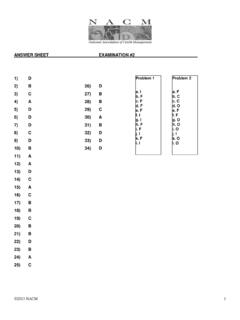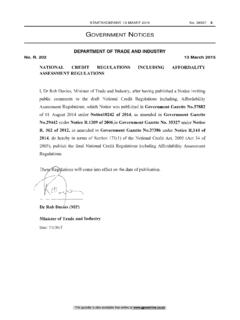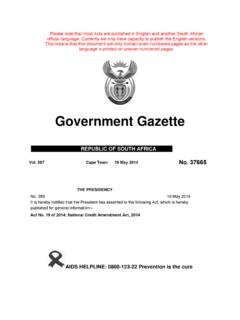Transcription of Report for September 2019 - web.nacm.org
1 NACM CMI 1 April 2018 Report for April 2018 Issued April 30, 2018 national Association of Credit Management Combined Sectors There are some growing signs of economic distress showing up. Now we can add the results of the latest Credit Managers Index (CMI) to that list. The numbers are not awful at this point many of the indicators are still solidly in expansion territory, but the warning lights are starting to blink, said NACM Economist Chris Kuehl, In just the last few weeks, there has been more concern over inflation and the eventual Fed reaction. Yields for the 10-year treasury just broke through the 3% psychological barrier. That has many wondering what interest rates will look like.
2 Some of that caution seems to be showing up among credit managers as well. The combined index number slipped to , a low not seen since May of 2017 nearly a year ago and before all the growth activity taking place at the start of this year. The index of favorable factors remains in the 60s, but just barely at The March reading was There is really no cause for much alarm at this point as is still an awfully strong number, but the trend is not what would be preferred. The sales reading actually went up from to , while new credit applications stayed stable with a reading of following last month s The stunner this month is in dollar collections. The collapse is almost hard to fathom as the reading fell out of the 60s with a resounding thud all the way to deep into the contraction zone (a reading under 50) at Kuehl suggests that this may be an anomaly, but it would be an enormous change and signals a level of distress that was not anticipated.
3 The amount of credit extended also remained about as it has been at compared to in March. The combined score for the unfavorable factors also showed some distress as well, with a reading of compared to the month prior. He noted that the last time the index was in the 40s was in July of last year. All but two of the readings are now in the contraction zone. The rejections of credit applications slipped a bit, but stayed above 50 with a reading of 51 after March s The accounts placed for collection reading slid out of the expansion zone as it fell to after having been at The disputes reading actually improved a little, but remained in the contraction zone with a reading of 48 after falling to in March. The dollar amount beyond terms data also fell again and now sits at as compared to This is the lowest point reached since May of last year.
4 That constitutes another warning shot. It looks like creditors are having more challenges as far as staying current, which may be contributing to the very weak dollar collection numbers, explained Kuehl. There was also a reduction in the numbers as far as dollar amount of customer deductions (from to ). The only other reading that has managed to stay in the expansion zone was filings for bankruptcies as it went from to Kuehl summarized the findings for the combined index by saying that the overall sense of the data this month is reduced enthusiasm. There is not an immediate crisis manifesting as long as the favorable factors are in the 60s, but the collapse in the dollar collection numbers is worrying. This may be nothing more than a timing anomaly there have been other examples of this in the data this year.
5 Extreme weather has taken its toll and there has been a lot of uncertainty regarding trade and tariffs. The fact is that both dollar collections and slow pays have been volatile this year. This may be another example of that volatility. As the economy has recovered with some speed, there have been companies that have been forced to try to keep pace with their competitors, but really don t have the ability to do so without lots of credit. Now they may be struggling to keep on top of that debt. The economy as a whole has continued to grow, but some sectors have not been as robust as others retail is still down and there have been stutters in manufacturing and export-oriented sectors. NACM CMI 2 April 2018 Combined Manufacturing and Service Sectors (seasonally adjusted)
6 Apr '17 May '17 Jun '17 Jul '17 Aug '17 Sep '17 Oct '17 Nov '17 Dec '17 Jan '18 Feb '18 Mar '18 Apr '18 Sales New credit applications Dollar collections Amount of credit extended Index of favorable factors Rejections of credit applications Accounts placed for collection Disputes Dollar amount beyond terms Dollar amount of customer deductions Filings for bankruptcies Index of unfavorable factors NACM Combined CMI Manufacturing Sector There has been a lot of turmoil in the manufacturing community of late.
7 The announced steel and aluminum tariffs have hit costs very hard. Even with all the exemptions that have been subsequently announced, there is concern that prices will continue to escalate. At the same time, there has been a general sense that oil prices are on their way up to old highs. Nearly every manufacturer has been reporting that logistics costs are going way up as well. This is on top of the ongoing issue of labor shortages, which has only become more acute with each passing year. The combined score for manufacturing slipped from to 54, taking the numbers back to where they were in January. This is not a massive decline as of yet, but it had been hoped that positive trends would start to dominate by this time.
8 The favorable factors fell out of the 60s, but not by much as the latest reading is after being at Apr '17 May '17 Jun '17 Jul '17 Aug '17 Sep '17 Oct '17 Nov '17 Dec '17 Jan '18 Feb '18 Mar '18 Apr '18 +/- Index Combined Index Monthly Change (seasonally adjusted) NACM CMI 3 April 2018 in March. The unfavorable index stayed almost the same as last month after a reading of still hugging the expansion zone by the skin of its teeth. The sales category improved from to That takes these numbers close to what they were in June of last year ( ). The new credit applications numbers shifted down a little, but stayed in the expansion zone by moving from to The big change was in dollar collections where the numbers cratered.
9 The reading was at in March and is now at Similar to the combined score ( to ), this is a very dramatic change. I t is not altogether clear this change is permanent there are some anomalies that may have played a role, said Kuehl. The amount of credit extended also improved a little to 66 from the previous month s reading of The data in the unfavorable categories stayed about the same with most of the readings close to expansion status, but still stuck in the contraction zone. The rejections of credit applications shifted down from to , but at least it is still in expansion territory. The accounts placed for collection dropped out of the expansion zone with a reading of after being at 51.
10 The disputes category improved, but still languishes in contraction territory as it moved from 46 to 48. The dollar amount beyond terms stayed about where it was last month with a reading of compared to The dollar amount of customer deductions dropped very slightly from to essentially staying the same. Finally, the filings for bankruptcies reading went from to In all, these numbers remained very similar to what they have been not really great but not getting appreciably worse. The sense is that there may be a breather under way a time that manufactures are taking to sort out some of the issues surrounding trade wars and tariffs and the overall expected pace of growth now that interest rates are headed up and markets are getting nervous, he concluded.









